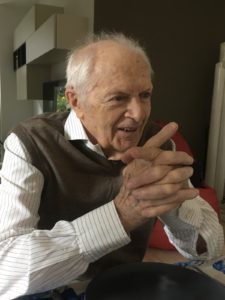 Luigi Pasinetti was born in the village of Zanica in Lombardy, Italy in 1930 and died in Varese, Lombardy on January 31, 2023.
Luigi Pasinetti was born in the village of Zanica in Lombardy, Italy in 1930 and died in Varese, Lombardy on January 31, 2023.
He took his first degree from Università Cattolica in Milan in 1955, where he spent most of his academic life, with long spells in Cambridge, UK, first as a student – having obtained his Ph.D. in 1963 – then as Lecturer and finally Reader in 1973, when he left for resuming his post as Full Professor at his Alma Mater. He had spent a year at Harvard (1957–58) and Oxford (1959–60), and during his intense working life was invited to give lectures in several universities at home and abroad.
He was a leading figure in many important institutions: Accademia Nazionale dei Lincei of which he was Fellow, President of the Italian Society of Economics, among the founders of the European Society for the History of Economic Thought of which he was its first President. His leadership was characterized by firm conviction of the importance of fencing the neoclassical approach to economics and securing a space for pluralism and diversity of methods.
The theoretical framework to which Pasinetti dedicated so much of his intellectual efforts was built on his understanding of what Cambridge economics was about and how its scope and aims should be pursued and integrated. As such it is a personal construction which stands, alongside the individual contributions by the Cambridge economists with whom Pasinetti associated himself, as a milestone in the landscape of non-mainstream economics. During his life Pasinetti offered important interpretations mainly of Sraffa and Keynes, but also of Richard Kahn, Joan Robinson and Nicholas Kaldor. With them he shared everyday Cambridge life, and he is universally associated with them in terms of a common “school”. In his 2007 book, Keynes and the Cambridge Keynesians, he wrote that Joan Robinson, Richard Kahn, Nicholas Kaldor and Piero Sraffa formed “a powerful school on the track of Keynes’s economic theory” and although he acknowledges that this “school” was in fact a group where strong ties, intellectual and emotional, weighed no less than differences in culture, attitude and political outlook, Pasinetti believed that there was: “something […] much deeper, that shaped their intellectual affinities or attractiveness and at the same time gave rise to their strong and stormy personal relationship” (Pasinetti 2007: 61 and 63). That “something much deeper”, according to Pasinetti, comes from having a common approach to economics. It must be said that if there is a Cambridge approach to economics, this is a task to be achieved, rather than the intellectual basis for characterising the group membership of these economists. It is something Pasinetti agrees with, having chosen as the subtitle of his book “a revolution in economics to be accomplished”. The goal is that of coupling the Cambridge approach and Classical Political Economy in the construction of a paradigm alternative to neoclassical economy.
The list of papers and books Pasinetti authored is too long to be recalled here, but perhaps a few landmarks may serve the purpose of illustrating his importance as one of the major figures in the post-war history of economics.
In Growth and Income Distribution: Essays in Economic Theory (1974) he deals with growth theory, income distribution and the laws of dynamics of capitalist systems; Lectures on the Theory of Production (1977) covers much of what he taught at Cambridge, namely input-output analysis and his structural change model. In Structural Change and Economic Growth (1981) and Structural Economic Dynamics (1993), he exposes the main lines of a research agenda which was then embraced by several scholars and pupils all over the world.
 He addresses the problems of maintaining full employment in a multi-sector economic system with a growing population and different rates of technical progress in different sectors. This approach is carried out, not in terms of input-output relations, as has become customary in multi-sector models, but rather in terms of vertically integrated sectors. This makes it possible to analyze the economic growth process in terms of the structural dynamics of production, of prices and of employment. The 1981 book is a theoretical investigation of the influence of human learning on the development through time of a “pure labour” economy. The theory proposed is a simple one but aims to grasp the essential features of all industrial economies. Within a multi-sector framework, Pasinetti examines the structural dynamics of prices, production and employment (implied by differentiated rates of productivity growth and expansion of demand) against a background of “natural” relations. He considers, however, several institutional problems, such as institutional and social learning, know-how, and the diffusion of knowledge. Those are seen as the decisive factors accounting for the success and failure of industrial societies.
He addresses the problems of maintaining full employment in a multi-sector economic system with a growing population and different rates of technical progress in different sectors. This approach is carried out, not in terms of input-output relations, as has become customary in multi-sector models, but rather in terms of vertically integrated sectors. This makes it possible to analyze the economic growth process in terms of the structural dynamics of production, of prices and of employment. The 1981 book is a theoretical investigation of the influence of human learning on the development through time of a “pure labour” economy. The theory proposed is a simple one but aims to grasp the essential features of all industrial economies. Within a multi-sector framework, Pasinetti examines the structural dynamics of prices, production and employment (implied by differentiated rates of productivity growth and expansion of demand) against a background of “natural” relations. He considers, however, several institutional problems, such as institutional and social learning, know-how, and the diffusion of knowledge. Those are seen as the decisive factors accounting for the success and failure of industrial societies.
Characteristic of Pasinetti’s approach to research are respect for sources, accuracy and precise reference to facts and texts, which apply equally to his work as a theoretician and as an historian of economic thought, together with an impeccably rigorous style, sparing in adjectives but rich in details.There are traits of Pasinetti’s intellectual personality that I also want to emphasise: optimism in techniques, terse argumentation, the pleasure of mathematics, philological scruples, but also a constant concern for the broader implications of discourse, within the vast horizon of the great themes of economics and history.
Pasinetti was a man whose spirituality had profound roots in his religiosity, sense of duty and love and care for his family and friends. He had captivating smile, which was a means to show a variety of feelings, from approval and empathy to mild dissent. He had a quiet way to exercise command and authority, which did not make him any less a formidable opponent in discussions or meetings, since he pursued his ideas and objectives with equal determination. But he had great charm, to which in the end it was easy to succumb.
We will miss him.
Maria Cristina Marcuzzo
Sapienza, Università di Roma
Accademia Nazionale dei Lincei
References
Pasinetti, L.L. (1974), Growth and Income Distribution: Essays in Economic Theory, Cambridge: Cambridge University Press.
Pasinetti, L.L. (1977), Lectures on the Theory of Production, New York: Columbia University Press and London: Macmillan.
Pasinetti, L.L. (1981), Structural Change and Economic Growth: A theoretical essay on the dynamics of the wealth of nations, Cambridge University Press, Cambridge.
Pasinetti, L.L. (1993), Structural Economic Dynamics ‐ A Theory of the Economic Consequences of Human Learning, Cambridge: Cambridge University Press.
Pasinetti, L.L. (2007), Keynes and the Cambridge Keynesians: a ‘Revolution in Economics’ to be Accomplished, Cambridge: Cambridge University Press.
